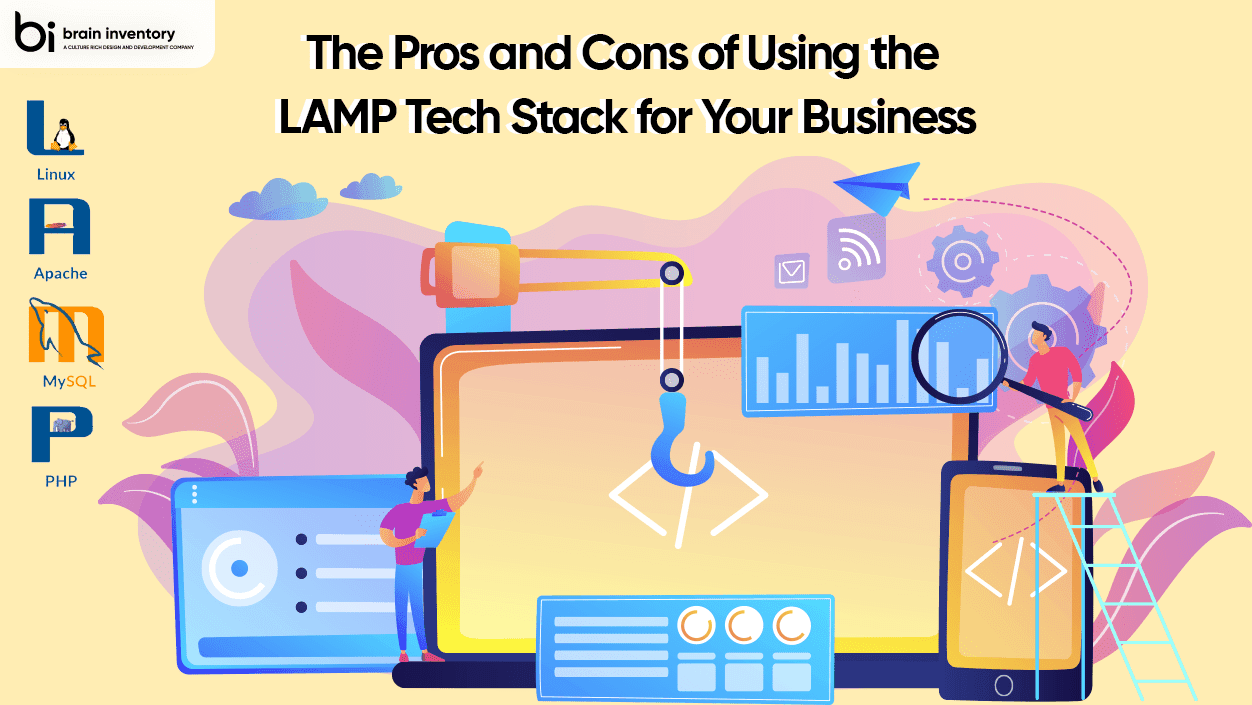The Pros and Cons of Using the LAMP Tech Stack for Your Business

Quick Summary: The LAMP Tech Stack is an open-source software stack that stands for Linux, Apache, MySQL, and PHP (it’s actually an acronym). This collection of technologies has become very popular with new websites. While it first became popular in 1998, it remains a popular tool for web app development and website development.
What is LAMP Stack?
The LAMP tech stack consists of Linux, Apache, MySQL, and PHP. Each component plays a vital role in creating a stable website environment. While each component can be swapped out for something else, the LAMP stack is a powerful combo that matches well with hosting providers that readily offer this technology. The LAMP stack was originally created back in the mid-nineties when Linux was first developed. Apache was also released at roughly the same time as both projects increased in popularity–this made it easy for people to create websites without specialized server requirements beyond just having an Internet connection and knowing how to access the server via FTP.
Linux: The operating system that forms the foundation of the stack. Linux provides a stable and secure environment for web applications.
Apache: The web server software that handles HTTP requests and serves web content to users’ browsers. Apache is known for its reliability and scalability.
MySQL: A relational database management system (RDBMS) used for storing and managing the application’s data. MySQL is renowned for its speed and versatility.
PHP: A server-side scripting language that is used to build dynamic web pages and interact with the database. PHP is a versatile language for web development and is often used in conjunction with the other components of the stack.
Advantages of LAMP Tech Stack
Flexibility:
A term that has been heavily in use since the early 2000s is “LAMP stack.” It refers to the recent shift in focus on using open-source technologies to create the perfect environment for running a website. The acronym stands for Linux, Apache, MySQL, and PHP. LAMP technology is one of the most commonly used stacks today. This was seen as an improvement over earlier versions as a hosted platform, specifically when it relates to more complex scripts and software needs.
Efficiency:
A LAMP stack is a common technology combination used to deliver dynamic web content. Many developers find it easier to build a solution that applies the latest technologies and standards on an existing code base instead of coming up with a fresh new technology stack. The benefit is that LAMP allows your web development team to leverage libraries of streamlined solutions already available in the community, in the open-source environment, and advances your business-ready product one step closer to showtime.
Capability:
LAMP – which is an acronym for Linux, Apache, MySQL, and PHP – is a solution for building infrastructure to construct web-based applications. Developers working within LAMP use highly customizable open-source tools that work alongside one another seamlessly; they can manage underlying databases and develop content and apps within the code utilizing language-specific frameworks.
Freelance:
Freelance software developers can be advantageous if you want to hire someone temporarily to complete a project. They may also be good if you want to save upfront costs and pay some of your labor costs after the work is completed. Although working with them can have its drawbacks as well. For example, freelancers aren’t as committed to a long-term partnership as employees who work in-house or are outsourced.
Other benefits of LAMP stack development include:
- The LAMP stack has a large and active community of developers and users. This means you can find a wealth of documentation, tutorials, and forums to help with troubleshooting and development.
- Linux, Apache, MySQL, and PHP are well-known for their security features and regular updates. Properly configured, LAMP applications can be highly secure.
- PHP is known for its rapid development capabilities, which can significantly speed up the development cycle of web applications.
- LAMP-based applications can be deployed on various operating systems, making them versatile and adaptable to different server environments.
- When properly optimized, LAMP applications can offer excellent performance and responsiveness, ensuring a seamless user experience.
- Since all components are open source, you have the freedom to customize and tailor your stack to meet specific project requirements.
Disadvantages of LAMP Stack Development:
Lack of Separation:
The LAMP hosting stack is the most popular web application platform built from open-source technologies. While it’s definitely cost-efficient and has a following in the developer community, because of its lack of mobility, it can cause problems if a server is faced with an extreme load. This can be caused by traffic spikes or a host that is under-provisioned for the amount of code present on their network, which could affect your site’s speed or functionality. By taking advantage of a more flexible hosting provider, you will not only have access to better control over your server, but you will likely also be able to experience faster page loads and better uptime than you ever have before.
Library Captivity:
Depending on your hosting setup, you may not have any control over the libraries. Some providers use a shared server. With this type of setup, it is impossible to upgrade PHP. It will simply break other websites that are using it. The only option with most shared hosting providers is updating the libraries used by the Apache HTTP server. Thankfully, it is very easy to install a newer version, since there are excellent guides and tutorials available on the Internet. In general, you should avoid using shared servers for PHP development.
Limited Scalability of Infrastructure:
There are numerous LAMP stack tutorials available but most of them are either incomplete or poorly organized. LAMP stack is not a straightforward concept to get right, so looking for a single resource can be a frustrating experience.
Conclusion
In this article, we will provide a detailed overview of what the LAMP stack is, how it is used to develop applications, and why businesses are choosing it more than any other technical solution. You need an agency that understands your technical requirements. Brain Inventory offers LAMP Application Development Services and works with a team of LAMP stack developers who have experience in developing websites and apps for Fortune companies, eCommerce companies, SMEs, and funded start-ups. If you’re looking to Hire Remote Developers India, we have the expertise to match your project needs. Contact us today at 810-956-1401 to find out how we can help you develop the app or website you want.

Have an idea?
Get in touch, we’d be
happy to hear from you
We are always looking out for new collaborations, whether you are a client who is passionate about a project or a talent who is interested in joining our team, our doors are always open.
locate us

India (HQ)
618, Shekhar Central, Palasia Square, A.B Road, Indore, Madhya Pradesh, 452001
+918109561401

United Kingdom
Brain Inventory, SBVS, 8 Roundhay Road, Leeds, UK, LS7 1AB
+18008209286

Canada
44 Main Street East Milton, ONCanada L9T 1N3
+4166696505

Jordan
185 Wasfi Al-Tal Street, Ammon Oasis Complex P.O Box 4724 Amman 11953 Jordan
+960770781000

USA
720 Seneca St Ste 107 Seattle, USA 98101
+1(206)6533419
if it's digital,we'll make it.
- Numetric - Online Accounting Software similar to QuickBooks
- Bloomia - Kegel exercise
- Virifi - Blockchain Powered Document Certification & Signing Platform
- Revolution Travel CRM - Custom CRM Built for Travel Agents
- Fatoura - Online Invoicing Platform
- My Fit Mantra - Your health partner
- Ocureel - Relation Building and video sharing Application